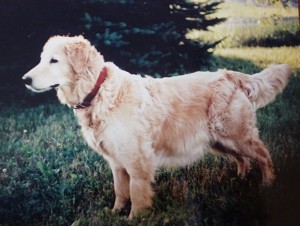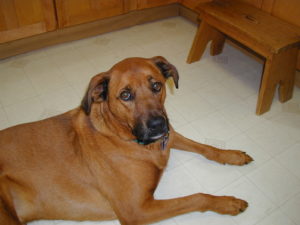(Click on this link to listen to an audio version of this blog … Big Dog, Little Dog
If you think about it, individuals in most mammalian species are pretty similar to each other in size. There is always some variability in body size, of course, but even a “small” elephant is still pretty big, and even a “large” shrew or mouse is still pretty small. A notable exception to this relative uniformity of a species’ individual sizes are dogs (Canus lupus familiaris).
Human breeders, especially over the past 200 years, have been the selective agents that have pieced together the hundreds of different breeds of dogs. Selection for types of coats, types of ears, types of tails, intelligence, behaviors, temperament and size were all part of breeding plans that were deigned to put together animals that could assist humans in their work, protect them from harm, or just provide them with a warm, soft, non-judgmental companion. But, how could dogs, or any mammalian species for that matter, have the phenotypic plasticity in its narrow range of “natural sizes” to breed out a chihuahua (4 to 6 pounds and 6 to 10 inches tall at the shoulder) and a English mastiff (up to 230 pounds and 30 inches tall at the shoulder)?
There are twenty-five genes in a dog’s genome that play a role in determining the ultimate size of the adult dog. One of these genes, gene “IGF1,” which, interestingly was the first dog-size gene to be described (back in 2007), encodes for a protein that plays a very significant, if not dominant, role in determining a dog’s size. Many previous studies have clearly shown that the protein encoded by IGF1 was the major metabolic player in size determination. Gene IGF1, though, did not seem to vary among breeds of dogs even among dogs that had a very wide range of sizes. Large dogs, medium-sized dogs and small dogs all had the same, or al least very similar, IGF1 gene.
So, how do big dogs and small dogs come about if they all have the same, main growth gene?
Exploration of other, non-protein encoding parts of a dog’s DNA revealed a possible answer. These “non-gene” sections of DNA used to be referred to, more than a little sneeringly, as “junk DNA.” These DNA sections do not encode for messenger RNA (mRNA) molecules that ultimately transcribe the proteins that control the metabolism of a cell, and, for that reason, are not referred to as “genes.” Instead, many of these “junk” DNA sequences encode for other types of RNA that regulate both transcription (the synthesis of mRNA by genes) and translation (the actual synthesis of proteins from the information encoded in the gene’s mRNA). And, very significantly, these non-gene sections of DNA are copied just like gene sequences of DNA during cell division and are very carefully separated during gamete synthesis and then passed along to the parental organisms’ off-spring!
One of these “junk” sections of a dog’s DNA turned out to make an RNA that is called an “anti-sense” RNA molecule. These anti-sense RNA’s are important in controlling the amount of protein that is produced by a gene-synthesized mRNA molecule. The “junk” DNA section that was identified made an anti-sense RNA molecule that controlled the synthesis of the growth protein encoded by the IGF1 gene! This “junk” section of DNA is called “IGF1-AS.”
It turns out that big dogs and little dogs and all of the medium-sized dogs in between are physiologically determined by the configuration of the two versions of IGF1-AS that they inherit from their parents. One of these IGF1-AS configurations speeds up the synthesis of the main, metabolic growth protein while the other slows this synthesis down. When a dog inherits two versions of the “fast” (or “large”) IGF1-AS in its genome, it grows into a large dog (more than 25 kg (55 pounds)), but when a dog inherits two versions of the “slow” (or “small”) IGF1-AS in its genome, it grows into a small dog (less than 15 kg (33 pounds). When a dog inherits one fast version and one slow version of IGF1-AS, it grows into a medium-sized dog (with body weights in-between 15 and 25 kg.
The study that explored the inheritance and impacts of these “fast” and “slow” anti-sense RNA molecules examined the genomes of 1400 canids. These canids included 230 modern dog breeds, and also coyotes, jackals, wolves (both modern and ancient), foxes and ancient dogs. The result of this study was published in Current Biology on January 27, 2022.
Coyotes, jackals and foxes each have two versions of the “small IGF1-AS. This suggests that this small version is, in fact, the older version of this gene. The ecological and evolutionary success of these three very widespread and very adaptable canids were likely facilitated by the relatively small size of their individuals. A smaller canid can more easily hide and evade predators. It also needs to eat less food in order to sustain itself. The furtive, scavenging nature of these three canids was best facilitated by a smaller body size. An ancient, Siberian wolf from about 53,000 years ago also only had the “small” versions of IGF1-AS, and it is assumed that it had behaviors and ecological roles more similar to coyotes and jacals than present day wolves.
Other ancient wolf species, though, along with the modern grey wolf had, like modern dogs, both the “small” and the “large” versions of IGF1-AS! The appearance of the “large” version of IGF1-AS was dated back to about 50,000 years ago. The wolf species that had the metabolic ability to attain large sizes were those wolves that inhabited the harsh, frozen lands of the past Ice Age. Larger sized bodies would have helped these species not only take the large prey species that also occupied these cold habitats but also would have helped the wolves survive the cold temperatures of their Ice Age realms.
Modern dogs are thought to have arisen from some now extinct evolutionary forerunner of the grey wolf. Probably these first dog-wolves that began to associate with humans about 15,000 years ago (see Signs of Spring 1, March 4, 2021) were dominated by medium sized individuals that had both the “large” and ”small” versions of IGF1-AS. Modern day feral dog populations are also overwhelmingly medium-sized and “heterozygotic” in the IGF1-AS versions. These first dog-wolves, though, had the potential in their DNA to attain the very small and the very large body sizes of modern dogs once the domesticated, human-led selection process of selective breeding began!







